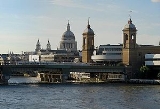
Cannon Street station rail crash
Encyclopedia
The Cannon Street station rail crash was an accident on the British railway system which occurred on 8 January 1991 at Cannon Street station
. The accident killed two people and injured 524 others. The 07:58 commuter train composed of elderly Class 415 and Class 416
units from Sevenoaks
failed to stop at a dead end on Platform 3 and collided with a buffer stop
at around 10 mph http://www.railwaysarchive.co.uk/eventsummary.php?eventID=154&PHPSESSID=2e2e139d04c058eb268f8a85623d0372.
could be found and the driver, Maurice Graham, was held to blame. He was not tested for drugs
until three days after the accident, whereupon traces of cannabis
were found in his system. The public inquiry
found that there was insufficient evidence to suggest this had caused the accident.
The inquiry found that the cause of the accident was solely that of driver error. The report also made the following observations:
Cannon Street station
Cannon Street station, also known as London Cannon Street, is a central London railway terminus and London Underground complex in the City of London, England. It is built on the site of the medieval Steelyard, the trading base in England of the Hanseatic League...
. The accident killed two people and injured 524 others. The 07:58 commuter train composed of elderly Class 415 and Class 416
British Rail Class 416
British Rail Class 416 electric multiple units were built between 1953 and 1956. They were intended for inner suburban passenger services on London's Southern Electric network...
units from Sevenoaks
Sevenoaks
Sevenoaks is a commuter town situated on the London fringe of west Kent, England, some 20 miles south-east of Charing Cross, on one of the principal commuter rail lines from the capital...
failed to stop at a dead end on Platform 3 and collided with a buffer stop
Buffer stop
A buffer stop or bumper is a device to prevent railway vehicles from going past the end of a physical section of track.The design of the buffer stop is dependent in part upon the kind of couplings that the railway uses, since the coupling gear is the first part of the vehicle that the buffer stop...
at around 10 mph http://www.railwaysarchive.co.uk/eventsummary.php?eventID=154&PHPSESSID=2e2e139d04c058eb268f8a85623d0372.
Inquiry
A report was compiled of the accident by Her Majesty's Railway Inspectorate. No fault in the train's braking systemBrake (railway)
Brakes are used on the cars of railway trains to enable deceleration, control acceleration or to keep them standing when parked. While the basic principle is familiar from road vehicle usage, operational features are more complex because of the need to control multiple linked carriages and to be...
could be found and the driver, Maurice Graham, was held to blame. He was not tested for drugs
Drug test
A drug test is a technical analysis of a biological specimen – for example urine, hair, blood, sweat, or oral fluid / saliva – to determine the presence or absence of specified parent drugs or their metabolites...
until three days after the accident, whereupon traces of cannabis
Cannabis (drug)
Cannabis, also known as marijuana among many other names, refers to any number of preparations of the Cannabis plant intended for use as a psychoactive drug or for medicinal purposes. The English term marijuana comes from the Mexican Spanish word marihuana...
were found in his system. The public inquiry
Public inquiry
A Tribunal of Inquiry is an official review of events or actions ordered by a government body in Common Law countries such as the United Kingdom, Ireland or Canada. Such a public inquiry differs from a Royal Commission in that a public inquiry accepts evidence and conducts its hearings in a more...
found that there was insufficient evidence to suggest this had caused the accident.
The inquiry found that the cause of the accident was solely that of driver error. The report also made the following observations:
- The age of the elderly trains increased the effect of the impact. Of the two coaches that suffered the worst damage, one was built on an underbody dating from 1934, having been refitted with a new body in 1953 and involved in a previous collision with a locomotive in 1958; the other was built on an underframe from 1928.
- The interior design of the coaches' fittings and the large number of slam doors could have resulted in weaknesses in the structure of the rolling stock.
- More research is needed on the effect of impacts on passengers, particularly standing passengers, on board commuter trains.
- Automatic Train ProtectionAutomatic Train ProtectionAutomatic Train Protection in Great Britain refers to either of two implementations of a train protection system installed in some trains in order to help prevent collisions through a driver's failure to observe a signal or speed restriction...
, or ATP, should be installed as quickly as practicably possible. - On-train data recorders would make the finding of evidence easier following railway accidents.
- Legislation should be introduced to make it an offence for railway staff with safety responsibilities to be intoxicated while on duty. (The main cause of the Eltham Well Hall rail crashEltham Well Hall rail crashThe Eltham Well Hall rail crash was an accident on the British railway system that occurred on 11 June 1972 at approximately 21:35.An excursion train from Margate to Kentish Town derailed on a sharp curve at Eltham Well Hall station, Eltham, London. The driver and five passengers were killed, and...
). - Sliding buffer stops might have minimised the injury compared to the hydraulic buffer stops in this incident.
- Arrangements for the booking-on of staff should be reviewed (a recommendation also made in the report for the Eltham Well Hall rail crashEltham Well Hall rail crashThe Eltham Well Hall rail crash was an accident on the British railway system that occurred on 11 June 1972 at approximately 21:35.An excursion train from Margate to Kentish Town derailed on a sharp curve at Eltham Well Hall station, Eltham, London. The driver and five passengers were killed, and...
).

